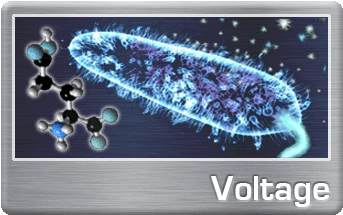Team:Cambridge/Voltage
From 2008.igem.org
| Line 21: | Line 21: | ||
Using the iGEM synthetic biology concept, we identified genes which could contribute to a synapse-like response. We also used a number of existing | Using the iGEM synthetic biology concept, we identified genes which could contribute to a synapse-like response. We also used a number of existing | ||
| - | [[IGEM:Cambridge/2008/Extracted_Parts | parts from the registry]]. To keep the system as simple and therefore feasible as possible the aim was to engineer E.coli to respond to a specific ligand by allowing a flux of ions which would be measurable as a small change in the voltage of the medium the cells are suspended in. The first step was to find prokaryotic ion channels which open or close in response to a particular molecule or small set of molecules. We searched the [http://www.uniprot.org/ Uniprot database] and found that the organism [http://www.ebi.ac.uk/2can/genomes/bacteria/Synechocystis.html Synechocystis PCC 6803] has a transmembrane protein, GluR0 | + | [[IGEM:Cambridge/2008/Extracted_Parts | parts from the registry]]. To keep the system as simple and therefore feasible as possible the aim was to engineer E.coli to respond to a specific ligand by allowing a flux of ions which would be measurable as a small change in the voltage of the medium the cells are suspended in. The first step was to find prokaryotic ion channels which open or close in response to a particular molecule or small set of molecules. We searched the [http://www.uniprot.org/ Uniprot database] and found that the organism [http://www.ebi.ac.uk/2can/genomes/bacteria/Synechocystis.html Synechocystis PCC 6803] has a transmembrane protein, GluR0 which is glutamate-gated, and allows flux of potassium ions when opened. We decided to try using the protein coding sequence of the gene for this channel. However, as the sequence came from a different organism, it was necessary to optimise the codons for expression in E.coli. We therefore decided to have the [[IGEM:Cambridge/2008/Notebook/Voltage/GluR0 Manipulation| GluRo Biobrick plasmid]] we had designed synthesised by DNA2.0. [[IGEM:Cambridge/2008/Notebook/Voltage/Gene Design|''Gene Design'']] |
Using the GluR0 channel defined our ion of interest as potassium. As potassium is a naturally present ion in organisms, E. coli has its own regulatory systems to control its concentration. However, our review of the literature suggested that E. coli only varies potassium concentration as a mechanism of osmoregulation. It has a number of proteins involved in this process: a potassium influx pump (Kdp), a potassium channel (Kch), and a potassium efflux channel (Kef). | Using the GluR0 channel defined our ion of interest as potassium. As potassium is a naturally present ion in organisms, E. coli has its own regulatory systems to control its concentration. However, our review of the literature suggested that E. coli only varies potassium concentration as a mechanism of osmoregulation. It has a number of proteins involved in this process: a potassium influx pump (Kdp), a potassium channel (Kch), and a potassium efflux channel (Kef). | ||
| Line 29: | Line 29: | ||
We ordered a variety of [[IGEM:Cambridge/2008/Notebook/Voltage/Mutant Strains |mutant E.coli strains]] with mutations in each of the genes coding for the potassium flux membrane proteins Kdp, Kch and Kef. To examine the behaviour of these mutant strains we grew them in a variety of potassium concentrations and used [[IGEM:Cambridge/2008/Notebook/Voltage/OD600 Calibration| OD600 readings]] to measure their [[IGEM:Cambridge/2008/Notebook/Voltage/K+ Growth|growth rates]]. We also measured [[IGEM:Cambridge/2008/Notebook/Voltage/K+ Concentrations| internal potassium concentrations]] using [[IGEM:Cambridge/2008/Notebook/Voltage/Flame Photometer Calibration|flame photometry]]. Unfortunately there was little difference seen between most of the mutants and the control strain, and flame photometry readings were not always reliable. | We ordered a variety of [[IGEM:Cambridge/2008/Notebook/Voltage/Mutant Strains |mutant E.coli strains]] with mutations in each of the genes coding for the potassium flux membrane proteins Kdp, Kch and Kef. To examine the behaviour of these mutant strains we grew them in a variety of potassium concentrations and used [[IGEM:Cambridge/2008/Notebook/Voltage/OD600 Calibration| OD600 readings]] to measure their [[IGEM:Cambridge/2008/Notebook/Voltage/K+ Growth|growth rates]]. We also measured [[IGEM:Cambridge/2008/Notebook/Voltage/K+ Concentrations| internal potassium concentrations]] using [[IGEM:Cambridge/2008/Notebook/Voltage/Flame Photometer Calibration|flame photometry]]. Unfortunately there was little difference seen between most of the mutants and the control strain, and flame photometry readings were not always reliable. | ||
| - | We used PCR to copy the Kdp sequence from the E.coli MG1655 genome | + | We used PCR to copy the Kdp sequence from the E.coli MG1655 genome. As the pump is an ATPase, we did not want it to be expressed during exponential phase as it could stunt growth. We therefore also used PCR to extract the osmY promoter from Biobricks developed by MIT in 2006. It is a stationary phase promoter, so by putting Kdp under its control, we could postpone its expression until the cells have stopped needing ATP for growth and division. |
| - | Unfortunately the ligation and expression of the [[IGEM:Cambridge/2008/Notebook/Voltage/BioBrick Manipulation| osmY-Kdp construct]] proved impossible | + | Unfortunately the ligation and expression of the [[IGEM:Cambridge/2008/Notebook/Voltage/BioBrick Manipulation| osmY-Kdp construct]] proved impossible and so it did not form part of our final tests. Instead, we simply grew the E.coli in high K+ concentrations (100mM) and re-suspended them in low [K+] before adding the agonist, glutamate. |
Transformation of the GluR0 plasmid into the mutant strains mentioned earlier did not work. Instead, we tried transforming into the more traditional expression strain DH5 alpha Z1, with success. Using very[[IGEM:Cambridge/2008/Notebook/Voltage/Output| sensitive electrodes connected to an amplifier and oscilloscope]] we have been able to see voltage changes on application of glutamate to the medium. | Transformation of the GluR0 plasmid into the mutant strains mentioned earlier did not work. Instead, we tried transforming into the more traditional expression strain DH5 alpha Z1, with success. Using very[[IGEM:Cambridge/2008/Notebook/Voltage/Output| sensitive electrodes connected to an amplifier and oscilloscope]] we have been able to see voltage changes on application of glutamate to the medium. | ||
Revision as of 21:45, 28 October 2008
|
||
 "
"
